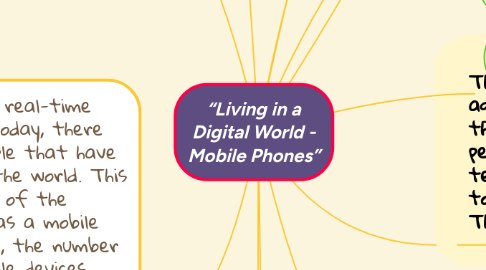“Living in a Digital World - Mobile Phones”
저자: Шырын Шаяхмет

1. Hardware
1.1. An input mechanism to allow the user to interact with the phone. These are a keypad for feature phones, and touch screens for most smartphones (typically with capacitive sensing).
1.2. A battery, providing the power source for the phone functions. A modern handset typically uses a lithium-ion battery (LIB), whereas older handsets used nickel–metal hydride (Ni–MH) batteries.
1.3. A display which echoes the user's typing, and displays text messages, contacts, and more. The display is typically either a liquid-crystal display (LCD) or organic light-emitting diode (OLED) display.
1.4. A central processing unit (CPU), the processor of phones. The CPU is a microprocessor fabricated on a metal–oxide–semiconductor (MOS) integrated circuit (IC) chip.
1.5. A hardware notification LED on some phones
2. According to GSMA real-time intelligence data, today, there are 5.22 Billion people that have a mobile device in the world. This means that 66.83% of the world's population has a mobile device. Back in 2017, the number of people with mobile devices was only 53% and breached the 5 billion mark.
3. China has the largest number of mobile users followed by India that has 502 million mobile phone users in Dec. 2019. In this article, we have published the name of the top 5 mobile manufacturers in the world.
4. The most common example of a cellular network is a mobile phone (cell phone) network. A mobile phone is a portable telephone which receives or makes calls through a cell site (base station) or transmitting tower. Radio waves are used to transfer signals to and from the cell phone
5. Smartphone Connectivity Guide
5.1. Wi-Fi
5.1.1. a facility allowing computers, smartphones, or other devices to connect to the Internet or communicate with one another wirelessly within a particular area.
5.2. 3G
5.3. 4G
5.4. 5G
5.5. GPS smartphone navigation
5.5.1. A 'Global Positioning System' is used to plot your position via satellite, allowing you to use a smartphone as a sat-nav. Standard GPS is fine, but if it's something you'll be using a lot it's worth enabling A-GPS. This 'Assisted' GPS uses data connectivity to improve performance and accuracy.
5.6. Bluetooth
5.6.1. a standard for the short-range wireless interconnection of mobile phones, computers, and other electronic devices.
6. Samsung – There’s a Samsung for everyone, from the bargain-basement J series and the excellent mid-range A series to the flagship S and Note series Apple – The iPhones are almost unmatched when it comes to hardware quality, and the company continues to set the benchmark for design Google – Despite being newcomers to the manufacturing market, Google’s recent phones are true flagship devices with market-leading features OnePlus – Continues to offer flagship features at mid-range prices, with high-end features and performance and impressive hardware Huawei – Security concerns aside, it’s impossible to deny the Chinese company makes some of the most impressive phones on the market Motorola – It’s had a hard few years, but still knows how to knock out a top quality mid-range phone Nokia – Once consigned to the smartphone graveyard, Nokia is back with a vengeance with a killer low- to mid-range lineup LG – Formerly a smartphone giant, LG’s handsets have struggled to find an identity in a crowded marketplace Sony – Another brand that’s fallen on hard times, Sony has lost the initiative on design and offers a truly baffling range of phones
6.1. Top 9 Mobile Phone Brands in the World
7. Feature phone is a term typically used as a retronym to describe mobile phones which are limited in capabilities in contrast to a modern smartphone. Feature phones typically provide voice calling and text messaging functionality, in addition to basic multimedia and Internet capabilities, and other services offered by the user's wireless service provider. A feature phone has additional functions over and above a basic mobile phone which is only capable of voice calling and text messaging. Feature phones and basic mobile phones tend to use a proprietary, custom-designed software and user interface.
8. Types
9. The digital age, also called the information age, is defined as the time period starting in the 1970s with the introduction of the personal computer with subsequent technology introduced providing the ability to transfer information freely and quickly. The era we live in today.
9.1. The first mobile phone call was made 40 years today, on April 3, 1973, by Motorola employee Martin Cooper.
10. Mobile phones were invented as early as the 1940s when engineers working at AT&T developed cells for mobile phone base stations. The very first mobile phones were not really mobile phones at all. They were two-way radios that allowed people like taxi drivers and the emergency services to communicate.
11. Smartphone Smartphones have a number of distinguishing features. The International Telecommunication Union measures those with Internet connection, which it calls Active Mobile-Broadband subscriptions (which includes tablets, etc.). In the developed world, smartphones have now overtaken the usage of earlier mobile systems. However, in the developing world, they account for around 50% of mobile telephony.
12. Standard smartphone features
12.1. Calendar
12.2. Mail
12.3. Internet
12.4. Dictaphone
12.5. Music
12.6. Camera
12.7. Lantern



